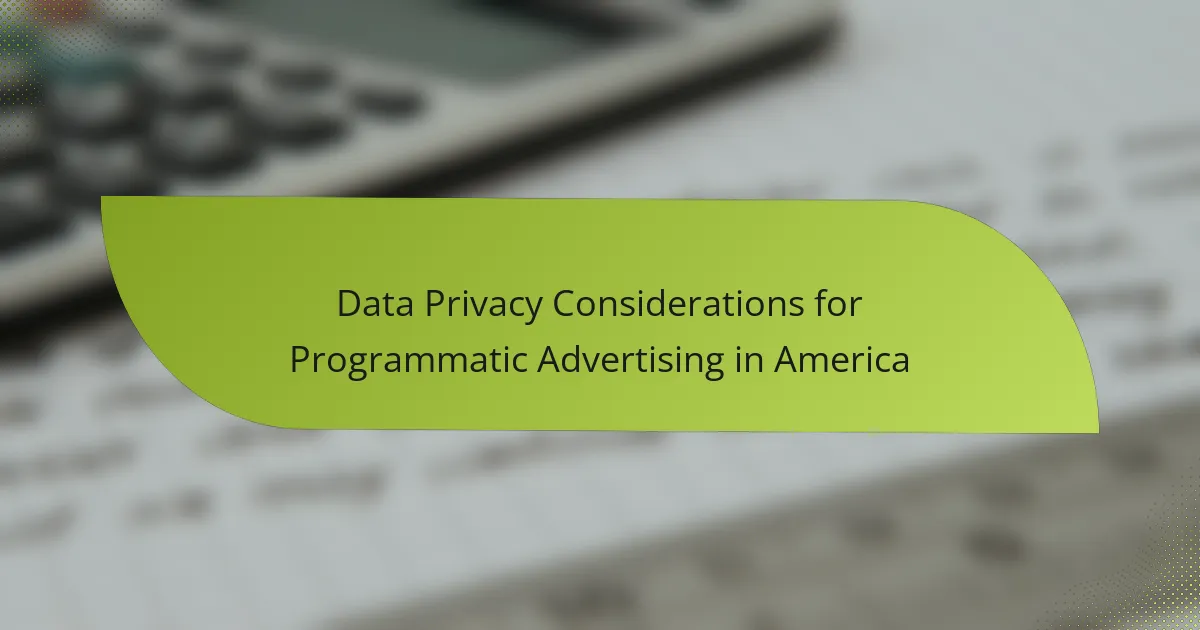Data privacy is a critical consideration in programmatic advertising within America, shaped by regulations such as the California Consumer Privacy Act (CCPA) and the Children’s Online Privacy Protection Act (COPPA). Advertisers must navigate these laws by adopting transparent data management practices, ensuring user consent, and protecting consumer identities to maintain compliance and foster trust. By prioritizing data privacy, companies can enhance their advertising strategies while respecting user rights.

What are the key data privacy regulations affecting programmatic advertising in America?
In America, key data privacy regulations impacting programmatic advertising include the California Consumer Privacy Act (CCPA), the General Data Protection Regulation (GDPR) implications, and the Children’s Online Privacy Protection Act (COPPA). These laws dictate how companies must handle consumer data, influencing advertising practices and compliance requirements.
California Consumer Privacy Act (CCPA)
The CCPA grants California residents specific rights regarding their personal information, including the right to know what data is collected, the right to delete it, and the right to opt-out of its sale. Businesses must provide clear disclosures about data collection practices and allow consumers to exercise their rights easily.
For programmatic advertising, companies must ensure compliance by updating privacy policies and implementing mechanisms for consumers to opt-out. Non-compliance can result in significant fines, making it crucial for advertisers to stay informed about CCPA requirements.
General Data Protection Regulation (GDPR) implications
While the GDPR is a European regulation, its implications extend to American companies that process data of EU residents. It mandates strict consent requirements for data collection and processing, emphasizing transparency and user control over personal data.
American advertisers engaging in programmatic advertising must ensure that their practices align with GDPR standards when targeting EU audiences. This may involve implementing consent management platforms and adjusting data handling processes to comply with GDPR’s stringent requirements.
Children’s Online Privacy Protection Act (COPPA)
COPPA protects the privacy of children under 13 by requiring parental consent before collecting personal information from minors. Advertisers must be cautious when targeting this demographic, ensuring compliance with COPPA regulations to avoid penalties.
For programmatic advertising, this means implementing age verification mechanisms and clearly defining target audiences. Advertisers should also review their data collection practices to ensure they do not inadvertently collect information from children without proper consent.

How can advertisers ensure compliance with data privacy laws?
Advertisers can ensure compliance with data privacy laws by implementing robust data management practices that align with regulations like the CCPA and GDPR. This involves obtaining user consent, regularly auditing data practices, and employing techniques to protect user identities.
Implementing consent management platforms
Consent management platforms (CMPs) are essential tools that help advertisers collect and manage user consent for data collection and processing. These platforms provide a user-friendly interface for individuals to opt in or out of data sharing, ensuring compliance with legal requirements.
When selecting a CMP, consider features such as customizable consent banners, detailed reporting capabilities, and integration with existing advertising technologies. A well-implemented CMP can enhance transparency and build trust with consumers.
Regular privacy audits and assessments
Conducting regular privacy audits and assessments is crucial for identifying potential compliance gaps in data handling practices. These audits should evaluate how data is collected, stored, and shared, ensuring that all processes align with current regulations.
Establish a schedule for audits, ideally on a quarterly basis, and involve stakeholders from various departments. This collaborative approach can help uncover issues early and facilitate timely corrective actions.
Data anonymization techniques
Data anonymization techniques are vital for protecting user identities while still allowing advertisers to analyze trends and behaviors. Methods such as data masking, aggregation, and pseudonymization can help ensure that personal information is not easily retrievable.
Implementing these techniques can reduce the risk of data breaches and enhance compliance with privacy laws. For example, using aggregated data for analysis can provide insights without exposing individual user identities, thus maintaining privacy while still enabling effective advertising strategies.

What are the best practices for data collection in programmatic advertising?
Best practices for data collection in programmatic advertising focus on transparency, user consent, and minimizing data usage. Implementing these practices helps build trust with users while ensuring compliance with regulations.
Transparent data collection policies
Transparent data collection policies are essential for fostering user trust. Companies should clearly communicate what data is being collected, how it will be used, and who it will be shared with. This can be achieved through easily accessible privacy policies and user-friendly interfaces.
Consider providing a summary of data practices in plain language, alongside a detailed policy document. This dual approach caters to both casual users and those seeking in-depth information.
Opt-in strategies for user consent
Opt-in strategies require users to actively consent to data collection, ensuring they are aware of and agree to the practices in place. This can be implemented through clear prompts during the user experience, such as checkboxes or pop-up notifications.
Offering incentives, like discounts or exclusive content, can encourage users to opt-in. However, it’s crucial to avoid dark patterns that manipulate user consent, as this can lead to distrust and potential regulatory issues.
Data minimization principles
Data minimization principles advocate for collecting only the data necessary for specific advertising purposes. This reduces the risk of data breaches and enhances user privacy. Companies should regularly assess their data needs and eliminate unnecessary information.
For example, if a campaign only requires demographic data, avoid collecting sensitive information like health or financial details. This not only aligns with best practices but also complies with regulations like the GDPR and CCPA, which emphasize data minimization.

How does data privacy impact targeting and personalization?
Data privacy significantly affects targeting and personalization in programmatic advertising by limiting the types of data that can be collected and used. Advertisers must navigate regulations and consumer expectations, which can restrict their ability to deliver tailored content and offers.
Limitations on third-party data usage
Restrictions on third-party data usage have become more stringent due to regulations like the GDPR and CCPA in the United States. Advertisers now face challenges in accessing comprehensive consumer profiles, which can hinder their ability to create targeted campaigns. As a result, relying solely on third-party data may not be viable, pushing advertisers to seek first-party data sources.
To adapt, businesses should invest in building their own data collection strategies, such as loyalty programs or direct customer engagement, to gather insights while respecting privacy concerns.
Impact on audience segmentation
Data privacy regulations can lead to less granular audience segmentation, as advertisers may have limited access to detailed consumer behaviors and preferences. This can result in broader targeting strategies that may not resonate as effectively with specific demographics. Consequently, advertisers need to be more creative in their segmentation approaches, focusing on contextual targeting and broad interest categories.
Utilizing first-party data can enhance segmentation efforts, allowing advertisers to tailor messages based on known customer interactions and preferences, thus improving relevance without compromising privacy.
Balancing personalization with privacy
Finding the right balance between personalization and privacy is crucial for effective programmatic advertising. Advertisers must respect consumer privacy while still delivering relevant content that drives engagement. This can be achieved by adopting transparent data practices and allowing consumers to control their data preferences.
Strategies such as offering clear opt-in choices and providing value in exchange for data can help maintain this balance. Advertisers should focus on creating personalized experiences that do not infringe on privacy, such as using aggregated data insights rather than individual-level data.

What tools can help manage data privacy in programmatic advertising?
Several tools can effectively manage data privacy in programmatic advertising, ensuring compliance with regulations and enhancing user trust. These tools streamline processes for consent management, privacy assessments, and ad personalization while maintaining user data security.
OneTrust for compliance management
OneTrust is a leading platform for compliance management that helps businesses adhere to data privacy regulations such as GDPR and CCPA. It provides features for managing user consent, tracking data processing activities, and automating compliance workflows.
Using OneTrust, companies can create privacy notices, conduct data mapping, and manage third-party vendor assessments. This ensures that all aspects of data handling are transparent and compliant, reducing the risk of penalties.
TrustArc for privacy assessments
TrustArc offers comprehensive privacy assessment tools that help organizations evaluate their data practices and identify potential risks. It provides a framework for conducting privacy impact assessments (PIAs) and ensures that privacy policies align with legal requirements.
With TrustArc, businesses can implement ongoing monitoring and reporting to maintain compliance. This proactive approach allows companies to adapt quickly to changes in privacy laws and consumer expectations.
Google Consent Mode for ad personalization
Google Consent Mode is a tool that allows advertisers to adjust how Google tags behave based on the consent status of users. This means that if a user does not consent to tracking, Google can still gather aggregated data without compromising individual privacy.
By integrating Google Consent Mode, advertisers can continue to personalize ads while respecting user choices. This balance helps maintain effective advertising strategies without violating privacy regulations, ultimately fostering a better relationship with consumers.

What are the challenges of data privacy in programmatic advertising?
Data privacy in programmatic advertising faces significant challenges, primarily due to evolving regulations, consumer skepticism, and limitations in tracking technology. Advertisers must navigate these issues to maintain compliance and build trust with their audience.
Increased regulatory scrutiny
Regulatory scrutiny around data privacy is intensifying, particularly with laws like the California Consumer Privacy Act (CCPA) and the General Data Protection Regulation (GDPR) in Europe influencing American practices. Advertisers must ensure they are transparent about data collection and usage, which can complicate programmatic strategies.
Compliance with these regulations often requires additional resources and adjustments to data handling processes. Failing to adhere to these laws can result in hefty fines and damage to brand credibility.
Consumer distrust and brand reputation
Consumer distrust regarding data privacy is a growing concern, as many individuals are wary of how their information is collected and used. This skepticism can lead to lower engagement rates and a reluctance to share personal data, which is crucial for effective programmatic advertising.
Brands must prioritize transparency and communicate their data practices clearly to build trust. Engaging in ethical data practices and showcasing commitment to privacy can enhance brand reputation and foster consumer loyalty.
Technological limitations in data tracking
Technological limitations pose a challenge for data tracking in programmatic advertising. Many tracking methods, such as cookies, are becoming less effective due to browser restrictions and privacy-focused changes in technology. This can hinder the ability to collect accurate data for targeting and measurement.
Advertisers should explore alternative tracking solutions, such as server-to-server integrations or first-party data strategies. Investing in robust analytics tools can also help overcome these limitations and improve data-driven decision-making.



